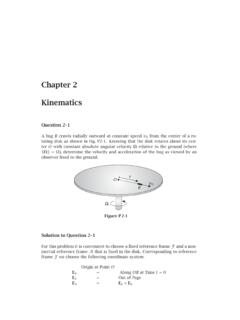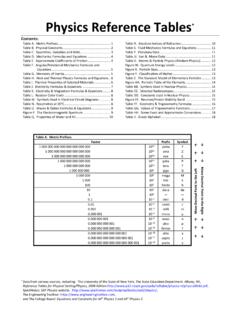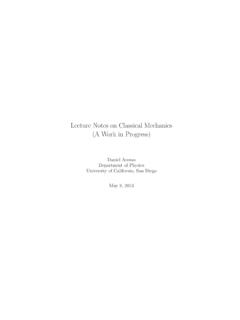Transcription of Physics 100A Homework 10 – Chapter 10 (part 2) - CSUN
1 Physics 100A Homework 10 Chapter 10 (part 2) ) After fixing a flat tire on a bicycle you give the wheel a spin. Its initial angular speed was rad/s and it rotated revolutions before coming to rest. A) What was its average angular acceleration? B) For what length of time did the wheel rotate? Picture the Problem: The bicycle wheel rotates about its axis, slowing down with constant angular acceleration before coming to rest. Strategy: Use the kinematic equations for rotation (equations 10-8 through 10-11) to find the angular acceleration and the time elapsed. Solution: 1. (a) Solve equation 10-11 for : ()()() rad/s22 rev 2 rad rev === 2.
2 (b) Solve equation 10-8 for t: rad/st === Insight: The greater the friction in the axle, the larger the magnitude of the angular acceleration and the sooner the wheel will come to rest. ) A discus thrower starts from rest and begins to rotate with a constant angular acceleration of rad/s2. A) How many revolutions does it take for the discus thrower's angular speed to reach rad/s? B) How much time does this take? Picture the Problem: The discus thrower rotates about a vertical axis through her center of mass, increasing her angular velocity at a constant rate. Strategy: Use the kinematic equations for rotation (equations 10-8 through 10-11) to find the number of revolutions through which the athlete rotates and the time elapsed during the specified interval.
3 Solution: 1. (a) Solve equation 10-11 for : ()() rad 1 rev 2 rev = === = 2. (b) Solve equation 10-8 for t: 0 rad/st == = Insight: Notice the athlete turns nearly one and a half times around. Therefore, she should begin her spin with her back turned toward the range if she plans to throw the discus after reaching rad/s. If she does let go at that point, the linear speed of the discus will be about m/s (for a m long arm) and will travel about m if launched at 45 above level ground. Not that great compared with a championship throw of over 40 m (130 ft) for a college woman.
4 When a carpenter shuts off his circular saw, the diameter blade slows from 4440 rpm to zero in s. A) What is the angular acceleration of the blade? B) What is the distance traveled by a point on the rim of the blade during the deceleration? C) What is the magnitude of the net displacement of a point on the rim of the blade during the deceleration? . Picture the Problem: The saw blade rotates about its axis, slowing its angular speed at a constant rate until it comes to rest. Copyright 2010 Pearson Education, Inc. All rights reserved. This material is protected under all copyright laws as they currently exist.
5 No portion of this material may be reproduced, in any form or by any means, without permission in writing from the publisher. 10 1 Chapter 10: Rotational kinematics and Energy James S. Walker, Physics , 4th Edition Strategy: Use the kinematic equations for rotation (equations 10-8 through 10-11) to find the angular acceleration of the saw blade and the angle through which the blade spins during this interval. Then use equation 10-2 to convert the angular distance to a linear distance. Solution: 1. (a) Solve equation 10-8 for : ()2004440 rev/min 1 min 60 st === 2. (b) Use equation 10-9 to find : ()()()110220 4440 rev/min s 1 min 60 revt = + = + = 3.
6 Convert to s: ()() in 12 in/ft rev 2 rad/rev242 ftsr = = = 4. (c) The blade completes exactly revolutions. With 92 revolutions it blade is back at the starting point. Half a revolution more a point on the rim ends up exactly opposite of where it started. Its displacement is therefore one blade diameter or in. Insight: If the blade had completed an integer number of revolutions, a point on the rim would end up exactly where it began and the displacement would be zero even though the distance it travels is hundreds of feet. ) A child pedals a tricycle, giving the driving wheel an angular speed of rev/s.
7 A) If the radius of the wheel is m, what is the child's linear speed? Picture the Problem: The drive wheel of the tricycle rolls without slipping at constant speed. Strategy: Because the wheel rolls without slipping, equation 10-15 describes the direct relationship between the center of mass speed and the angular velocity of the driving wheel. Solution: Apply equation 10-15 directly: ()() m rev/s 2 rad m/svr == = Insight: This speed corresponds to about mi/h, half the normal walking speed of an adult. The larger wheels on adult bicycles allow for higher linear speeds for the same angular speed of the driving wheel.
8 Kinetic Energy of a Rotating Wheel A typical ten-pound car wheel has a moment of inertia of about kg m2. The wheel rotates about the axle at a constant angular speed making full revolutions in a time interval of s. What is the rotational kinetic energy K of the rotating wheel? For constant angular speed srevt === rad/s 2211( )( )35222KI ===J Copyright 2010 Pearson Education, Inc. All rights reserved. This material is protected under all copyright laws as they currently exist. No portion of this material may be reproduced, in any form or by any means, without permission in writing from the publisher.
9 10 2 Chapter 10: Rotational kinematics and Energy James S. Walker, Physics , 4th Edition Kinetic Energy with Moment of Inertia Consider a particle of mass m = kg revolving around an axis with angular speed . The perpendicular distance from the particle to the axis is r = m. A) Which of the following are units for expressing rotational velocity, commonly denoted by ? radians per second, degrees per second, revolutions per second B) Assume = rad/s. What is the magnitude of the velocity of the particle in m/s? v( )( ) === m/s C) Now that you have found the velocity of the particle, find its kinetic energy K.
10 22222111()( )( ) (600)223222 KImr == == J D) Find the moment of inertia of the particle described in the problem introduction with respect to the axis about which it is rotating. Assume $\omega$ = rad/s. 22( )( ) kg m2 ) When a pitcher throws a curve ball, the ball is given a fairly rapid spin. A) If a baseball with a radius of cm is thrown with a linear speed of 48 m/s and an angular speed of 42 rad/s, how much of its kinetic energy is translational energy? Assume the ball is a uniform, solid sphere. B) How much of its kinetic energy is rotational energy? Picture the Problem: The ball rotates about its center with a constant angular velocity.
















